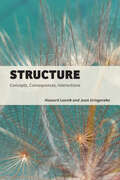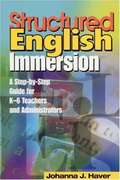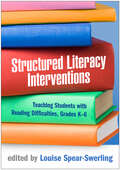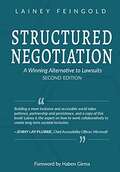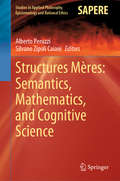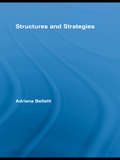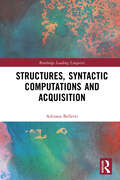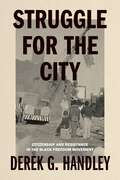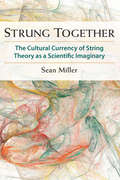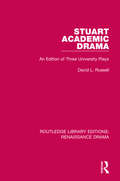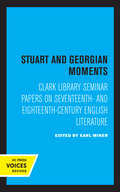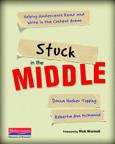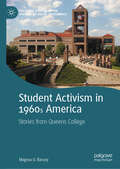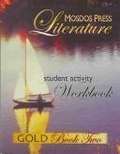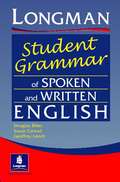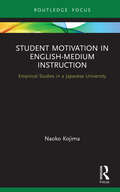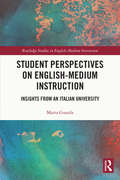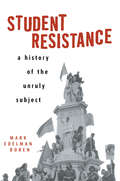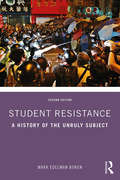- Table View
- List View
Structure: Concepts, Consequences, Interactions
by Juan Uriagereka Howard LasnikNatural phenomena, including human language, are not just series of events but are organized quasi-periodically; sentences have structure, and that structure matters.Howard Lasnik and Juan Uriagereka &“were there&” when generative grammar was being developed into the Minimalist Program. In this presentation of the universal aspects of human language as a cognitive phenomenon, they rationally reconstruct syntactic structure. In the process, they touch upon structure dependency and its consequences for learnability, nuanced arguments (including global ones) for structure presupposed in standard linguistic analyses, and a formalism to capture long-range correlations. For practitioners, the authors assess whether &“all we need is Merge,&” while for outsiders, they summarize what needs to be covered when attempting to have structure &“emerge.&”Reconstructing the essential history of what is at stake when arguing for sentence scaffolding, the authors cover a range of larger issues, from the traditional computational notion of structure (the strong generative capacity of a system) and how far down into words it reaches to whether its variants, as evident across the world&’s languages, can arise from non-generative systems. While their perspective stems from Noam Chomsky&’s work, it does so critically, separating rhetoric from results. They consider what they do to be empirical, with the formalism being only a tool to guide their research (of course, they want sharp tools that can be falsified and have predictive power). Reaching out to skeptics, they invite potential collaborations that could arise from mutual examination of one another&’s work, as they attempt to establish a dialogue beyond generative grammar.
Structured English Immersion: A Step-by-Step Guide for K-6 Teachers and Administrators
by Johanna J. HaverPresents the theory that children learning another language succeed more easily when in the company of other children who are fluent in the new language.
Structured Literacy Interventions: Teaching Students with Reading Difficulties, Grades K-6 (The Guilford Series on Intensive Instruction)
by Louise Spear-SwerlingComprehensive and evidence-based, Structured Literacy (SL) approaches place a high value on explicit, systematic, and sequential instruction. This book brings together leading experts to present a wealth of SL interventions for different components of literacy. Chapters describe instructional strategies for supporting phonological awareness, basic and multisyllabic word decoding, spelling, reading fluency, vocabulary, oral and reading comprehension, and written expression, especially for at-risk readers and those with disabilities. Including case studies, sample intervention activities, lesson plans, and end-of-chapter application activities, the book contains reproducible tools that can be downloaded and printed in a convenient 8½&“ x 11&” size. An NCTQ Exemplary Text for Reading Instruction See also Louise Spear-Swerling's authored volume, The Structured Literacy Planner: Designing Interventions for Common Reading Difficulties, Grades 1–9, which provides blueprints for tailoring interventions based on a learner's reading profile.
Structured Negotiation: A Winning Alternative to lawsuits
by Lainey FeingoldLainey is the expert on how to work collaboratively to create long term societal inclusion.” — Jenny Lay-Flurrie, Chief Accessibility Officer, Microsoft “This fantastic guide to structured negotiations provides valuable insights for anyone interested in becoming a better advocate. I really enjoyed reading this book and appreciate all the lessons within.” — Haben Girma, Human rights lawyer and author of the best seller, Haben, the Deafblind Woman Who Conquered Harvard Law. ——— Structured Negotiation: A Winning Alternative to Lawsuits shares stories and strategies from 25 years of successful collaborations between the disability community and some of the largest public and private organizations in the United States. Born at the intersection of accessibility, technology, disability, and dispute resolution, the pioneering strategy described in this book has been instrumental in creating a more inclusive digital world for a quarter century. First published by the American Bar Association, the Second Edition includes new Structured Negotiation win-wins, other new content, and Forewords by Haben Girma, author of the best-selling Haben: The Deafblind Woman Who Conquered Harvard Law and by Susana Sucunza, Basque Country Spain collaborative lawyer and president of the Basque Country Collaborative Law Association. Not just for lawyers, the book offers an effective and path-breaking method to resolve disputes without lawsuits, and to lessen the conflict and expense of filed cases. Lawsuits play an important role in moving society forward. But the legal profession ― and the public it serves ― deserve less costly, less stressful, and more cooperative and ethical alternatives. Clients need a forum where stories matter. Would-be defendants need a process that allows them to do the right thing without having to prove there is no problem to begin with.
Structures Mères: Semantics, Mathematics, and Cognitive Science (Studies in Applied Philosophy, Epistemology and Rational Ethics #57)
by Alberto Peruzzi Silvano Zipoli CaianiThis book reports on cutting-edge concepts related to Bourbaki’s notion of structures mères. It merges perspectives from logic, philosophy, linguistics and cognitive science, suggesting how they can be combined with Bourbaki’s mathematical structuralism in order to solve foundational, ontological and epistemological problems using a novel category-theoretic approach. By offering a comprehensive account of Bourbaki’s structuralism and answers to several important questions that have arisen in connection with it, the book provides readers with a unique source of information and inspiration for future research on this topic.
Structures and Strategies (Routledge Leading Linguists)
by Adriana BellettiFollowing crucial insights on the functional structure of the clause and recent developments within the cartographic projects and minimalism, this book addresses various central themes in Italian and Romance syntax ranging from verb syntax and the syntax of verb-related phenomena of agreement and cliticization, to word order issues and their status in discourse contexts. It illustrates a research program where the basic formal components of grammar, the rich cartographic syntactic structures, are directly implicated in morphosyntactic computations proper as well as in the articulation of discourse strategies.
Structures of Feeling in Seventeenth-Century Cultural Expression
by Susan McclaryBetween the waning of the Renaissance and the beginning of the Enlightenment, many fundamental aspects of human behaviour - from expressions of gender to the experience of time - underwent radical changes. While some of these transformations were recorded in words, others have survived in non-verbal cultural media, notably the visual arts, poetry, theatre, music, and dance. Structures of Feeling in Seventeenth-Century Cultural Expression explores how artists made use of these various cultural forms to grapple with human values in the increasingly heterodox world of the 1600s.Essays from prominent historians, musicologists, and art critics examine methods of non-verbal cultural expression through the broad themes of time, motion, the body, and global relations. Together, they show that seventeenth-century cultural expression was more than just an embryonic stage within Western artistic development. Instead, the contributors argue that this period marks some of the most profound changes in European subjectivities.
Structures, Syntactic Computations and Acquisition (Routledge Leading Linguists)
by Adriana BellettiThis book collects some of the most significant articles by Adriana Belletti published over the last ten years or so, offering readers a useful tool to see the mutual enrichment between linguistic theory and experimental studies on (modes of) language acquisition through her work. The volume explores domains of theoretical morphosyntax in the generative tradition and theoretically guided studies on language acquisition. An introduction specific to this volume contextualizes these contributions within ongoing developments in the field. Part I presents studies inspired by the illuminating interchange between linguistic theory and experimentation in the domain of language acquisition, leading to the formulation of explicit research questions tested experimentally and guiding in the proper interpretation of the results. Part II offers refined, detailed theoretical analyses of domains in which peripheral positions in the clause structures are crucially involved to express discourse contents, in sometimes not standard ways during development. Demonstrating how refined linguistic analyses play a crucial role in interpretating the peculiar shape of developmental data, this book will be of interest to scholars in syntax, language acquisition, and theoretical linguistics.
Structuring the Void: The Struggle for Subject in Contemporary American Fiction
by Jerome KlinkowitzIf, as the literary theorists of postmodernism contend, "content" does not exist, then how can fiction continue to be written? Jerome Klinkowitz, himself a veteran practitioner and theorist of fiction, addresses this question in Structuring the Void, an account of what today's novelists and short story writers do when they produce a fictive work. Klinkowitz's focus is on the way in which writers have turned this lack of content itself into subject matter, and, by thus "structuring the void," have created a new form of fiction.Among the writers Klinkowitz discusses are Richard Brautigan, Kurt Vonnegut, Max Apple, Saul Bellow, Erica Jong, Susan Quist, Gerald Rosen, Rob Swigart, and Grace Paley. He shows how, in the absence of subject matter, these writers persist in the act of structuring--by organizing autobiography as a narrative device, ritualizing national history and popular culture, or formalizing a comic response to a new imaginative state, the state of California. Klinkowitz also considers subjects such as gender and war, which, though they cannot be represented, nevertheless exercise contraints on a writer's intention to structure.What emerges from Klinkowitz's analysis is a clear sense of what today's fiction--and fiction writing--is about. As such, Structuring the Void will prove invaluable to anyone with an interest in contemporary literature.
Struggle for the City: Citizenship and Resistance in the Black Freedom Movement (Rhetoric and Democratic Deliberation)
by Derek G. HandleyThe urban renewal policies stemming from the 1954 Housing Act and 1956 Highway Act destroyed the economic centers of many Black neighborhoods in the United States. Struggle for the City recovers the agency and solidarity of African American residents confronting this diagnosis of “blight” in northern cities in the 1950s and 1960s.Examining Black newspapers, archival documents from Black organizations, and oral histories of community advocates, Derek G. Handley shows how African American residents in three communities—the Hill district of Pittsburgh, the Bronzeville neighborhood of Milwaukee, and the Rondo district of St. Paul—enacted a new form of citizenship to fight for their neighborhoods. Dubbing this the “Black Rhetorical Citizenship,” a nod to the integral role of language and other symbolic means in the Black Freedom Movement, Handley situates citizenship as both a site of resistance and a mode of public engagement that cannot be divorced from race and the effects of racism. Through this framework, Struggle for the City demonstrates how local organizers, leaders, and residents used rhetorics of placemaking, community organizing, and critical memory to resist the bulldozing visions of urban renewal.By showing how African American residents built political community at the local level and by centering the residents in their own narratives of displacement, Handley recovers strategies of resistance that continue to influence the actions of the Black Freedom Movement, including Black Lives Matter.
Strung Together: The Cultural Currency of String Theory as a Scientific Imaginary
by Sean MillerIn Strung Together: The Cultural Currency of String Theory as a Scientific Imaginary, Sean Miller examines the cultural currency of string theory, both as part of scientific discourse and beyond it. He demonstrates that the imaginative component of string theory is both integral and indispensable to it as a scientific discourse. While mathematical arguments provide precise prompts for physical intervention in the world, the imaginary that supplements mathematical argument within string theory technical discourse allows theorists to imagine themselves interacting with the cosmos as an abstract space in such a way that strings and branes as phenomena become substantiated and legitimized. And it is precisely this sort of imaginary--which Miller calls a scientific imaginary--duly substantiated and acculturated, that survives the move from string theory technical discourse to popularizations and ultimately to popular and literary discourses. In effect, a string theory imaginary legitimizes the science itself and helps to facilitate a virtual domestication of a cosmos that was heretofore remote, alien, and incomprehensible.
Stuart Academic Drama: An Edition of Three University Plays (Routledge Library Editions: Renaissance Drama)
by David L. RussellAlthough not much is known about the three Stuart plays in this edition, which was first published in 1987, we can ascribe them to one of the English universities, and each is indicative of a distinctly different influence on the Renaissance academic drama. Heteroclitanomalonomia is part of a minor subgenre referred to as the academic play. It demonstrates the predominance of language or rhetoric studies in the period and its very subject is of purely academic interest. Gigantomachia displays the continuing interest of the Renaissance in classical mythology. And A Christmas Messe follows a more homely tradition, a farcical personification of the mundane. This title will be of interest to students of English Literature, Drama and Performance.
Stuart and Georgian Moments: Clark Library Seminar Papers on Seventeenth- and Eighteenth-Century English Literature (UCLA Publications of the 17th and 18th Centuries Studies Group #3)
by Earl MinerThis title is part of UC Press's Voices Revived program, which commemorates University of California Press’s mission to seek out and cultivate the brightest minds and give them voice, reach, and impact. Drawing on a backlist dating to 1893, Voices Revived makes high-quality, peer-reviewed scholarship accessible once again using print-on-demand technology. This title was originally published in 1972.
Stuck In The Middle: Helping Adolescents Read And Write In The Content Areas
by Donna Topping Roberta McManusDon't get stuck when students struggle in the content areas. Get Stuck in the Middle. "Over the past thirty years, we have been developing and implementing teacher-friendly, student-oriented strategies to help all students learn through reading and writing-especially those who struggle. In these pages, we share with you ways to differentiate instruction so that all students learn more content, more effectively, while simultaneously improving the reading and writing abilities they bring to our classes." -Donna Hooker Topping and Roberta McManus When students are Stuck in the Middle you need the very best strategies to help them move forward-strategies that pass the test of real teaching, to real adolescents, in real time. Fortunately, the teaching that helps them most is good for everyone in your content-area classroom. Donna Hooker Topping and Roberta McManus help you support struggling middle school students with page after page of immediately useful, ready-for-differentiation teaching. These strategies work by making the process of content-area literacy transparent and repeatable. Without interrupting the flow of instruction, Donna and Roberta's strategies help adolescents: not only read texts but understand them too make crucial subject-area vocabulary stick grapple with themes, ideas, and content through writing find ways into content that fit individual learning styles. "Content-area teachers have a unique opportunity to help students not only learn the material but also improve their overall literacy," write Donna Hooker Topping and Roberta McManus, "so we offer our best strategies to you." If you want to know how to help struggling readers make sense of the textbook, if you need help differentiating, or if you are overwhelmed by the sheer numbers of learning styles in your classroom, trust Donna and Roberta's decades of experience. Pick up Stuck in the Middle and start getting students unstuck now.
Student Activism in 1960s America: Stories from Queens College (Palgrave Studies in the History of Social Movements)
by Magnus O. BasseyThis book sheds light on the untold stories of individual student activists at Queens College, New York City, during the 1960s. Against the backdrop of the ongoing Vietnam War and the assassination of President John F. Kennedy, some Americans began to lose faith in their government. Based on injustices that students saw in their campuses, in the country, and in the world at large, they began to question their political leaders. Students organized their discontents over three major issues: civil rights, free speech, and anti-war sentiments. Their protests involved direct actions such as sit-ins, marches, picketing, and boycotts. At Queens College (QC), as the students moved away from the repressive McCarthy era of the 1950s, they began to confront and challenge those in power at the college in the 1960s. The defining characteristic of this break from the past was a student strike in 1961 in objection to the ban of controversial speakers who had been invited to campus by student clubs. The student strike of 1961 gave the activists among them a direct and immediate way to fight power on campus and to fight racism and discrimination. The author argues that student movements cannot be attributed to a single explanation, and therefore, he focuses on individual historical contexts, presenting first-person narratives from the actual participants, and tells their stories in their own voices, from their own records, and from the documents they left behind. The book identifies the QC student activists of the 1960s, exploring how and why they became activists; their activities; their achievement as activists; and what motivated them to think that they could make history themselves by confronting racism. It provides an intimate look at the students’ lives and their social justice journey, beginning at Queens College and as they moved into their careers.
Student Activity Workbook: Companion to GOLD
by Judith FactorThe Gold workbook takes the tedium out of language and analytical exercises! It is clever and imaginative. There are two vocabulary exercises, one graphic organizer, and a research or creative writing activity for each of Gold’s prose selections. The vocabulary usage exercises often mimic the style of the great authors. Practice exercises with synonyms/antonyms/homonyms, word analogies, and tests of context are witty and instructive.
Student Companion All-in-One Workbook 7th Grade
by Prentice HallPearson Literature Common Core 7th Grade Workbook
Student Grammar of Spoken and Written English
by Geoffrey Leech Douglas Biber Susan ConradExamines patterns of use in the news, fiction and academic English Takes grammar and vocabulary together and looks at how they interact Is based on the analysis of 40-million words of British and American, written and spoken corpus text Uses over 3000 examples of real, corpus English to illustrate the points Uses frequency tables and graphs to make the new findings of this grammar clear
Student Motivation in English-Medium Instruction: Empirical Studies in a Japanese University (Routledge Focus on English-Medium Instruction in Higher Education)
by Naoko KojimaThis book explores Japanese students’ learning experiences and challenges in English medium instruction (EMI) from motivational perspectives. Using self-determination theory (SDT) as the framework, the first part reveals a lack of the three psychological needs of SDT (autonomy, competence, relatedness) that cause loss of students’ initial interest in learning English language and content. The author outlines pedagogical interventions that can be implemented in order to make the learning environment better. The second half of the book shows the effects these interventions had on the fulfillment of the three psychological needs, especially perceived relatedness and autonomy. In conclusion, the author focuses on the importance of listening to Japanese students’ voices and building a community that can motivate students, thus maximizing the pedagogical effectiveness of EMI. This volume will be useful to anyone involved in motivation, language learning or EMI research, pedagogy or practice.
Student Mybook Softcover Volume 1 Grade 5 (Into Reading)
by Houghton Mifflin HarcourtInto ReadingTM my Book
Student Perspectives on English-Medium Instruction: Insights from an Italian University (Routledge Studies in English-Medium Instruction)
by Marta GuardaThis book offers a window into student perceptions of English-Medium Instruction (EMI), building on research from an Italian university to provide a better understanding of attitudes toward EMI in Europe and future directions for cross-country comparative research.The volume provides context on the current situation with EMI in Italy, unpacking debates around the tensions between the increased competitiveness it brings at the higher education level with the potential detrimental impact of English on local language practices. Seeking to introduce a counterpoint to existing research on lecturer experiences, Guarda draws on a wide range of data, from online questionnaires to semi-structured interviews and a focus group, toshowcase perceptions on EMI from students enrolled in English-Taught Programmes at the University of Padova over a two-year period. The resulting insights contribute to the current literature on EMI toward creating a clearer and more holistic picture of the advantages and challenges of learning through English and implications for quality improvement measures for EMI implementation in Italy, Europe and beyond.This book will be of interest to scholars in English-Medium Instruction and applied linguistics, especially to those working on issues around language policy, bilingual education and the internationalisation of higher education.
Student Reader Two (Wilson Reading System®)
by Wilson Language Training CorporationThe word lists, sentences, and passages address core and academic vocabulary. Word lists include Level AB, Level A, and Level B vocabulary. Sentences and passages include targeted high frequency words as well as Level AB and Level B vocabulary.
Student Resistance: A History of the Unruly Subject
by Mark Edelman BorenStudent Resistance is an international history of student activism. Chronicling 500 years of strife between activists and the academy, Mark Edelman Boren unearths the defiant roots of the ivory tower.
Student Resistance: A History of the Unruly Subject
by Mark Edelman BorenStudent Resistance: A History of the Unruly Subject observes the rise and progression of student activism across the globe. By selecting critical case studies from the medieval to modern period, Mark Boren reveals how friction between activists and the academy can culminate in a violent struggle for power. Using a uniquely international approach, the book offers a comprehensive introduction to the history of university activism and its influence on national politics and broader social movements. Specific instances of resistance, from medieval uprisings across European universities to the Tiananmen Square Massacre, are explored to produce a detailed historical study of power relations and oppression. Globalization and rapid technological advances have established more accessible platforms for collective activism whilst recent political upsets have generated a ripe environment for students to increase their efforts of resistance. This second edition addresses repercussions of the internet and social media age on the evolution of campus activism in the United States and abroad, from #blacklivesmatter to the Palestinian West Bank protests. This timely revision of Student Resistance continues to reflect on the vital role that resistance plays in the evolution of modern societies and the book remains an essential text for both students and scholars of youth activism.
